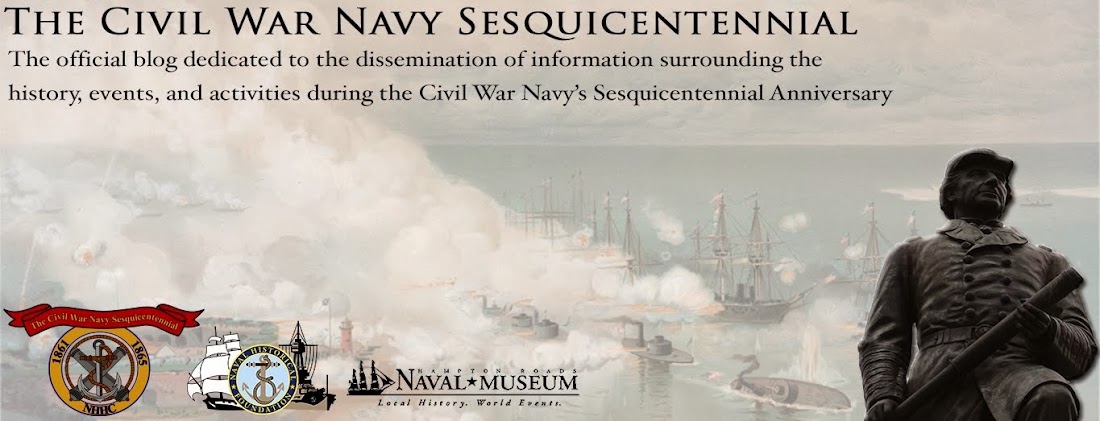1862 illustration shows captured British blockade runners. (U.S. Navy)
The Navy "changed the
trajectory of the war" was the way one of the nation's leading historians
described the service's contribution to the ultimate Union victory in 1865.
Speaking April 16 at the United
States Naval Institute's annual meeting in Washington, Dr. Craig Symonds,
co-winner of the 2009 Lincoln Prize for his Lincoln
and His Admirals, said the blockade of Confederate ports from the Carolinas
on the Atlantic to the Texas Gulf Coast "was the largest enterprise the
Navy undertook," ultimately involving more than 500 ships, more than 400
of them converted merchantmen -- "the last time that was still possible,"
and 100,000 men.
The Union Navy transformed itself
from a fleet of 42 ships scattered around the globe or in ordinary at shipyards
with a few thousand officers and experienced tars in 1861 to a technologically
adept force with rifled guns, iron-plated, screw propellers, etc. operating
with a "changed lower deck" of "volunteers. contrabands from the
South, free blacks from the North" in 1865.
When President Abraham Lincoln
announced the blockade, Symonds, a professor emeritus of history at the Naval
Academy, contends that he and Secretary of State William Seward understood that
it "was an act of war" and implied "a kind of recognition"
of the Confederacy.
But it proved hugely advantageous
for the Union. Great Britain. while
acknowledging the Confederacy as a belligerent, declared itself neutral in the
North American war and by doing that effectively closed off its ports,
particularly important in the Caribbean, to Confederate privateers or later its
commerce raiders trying to sell off their captured "prizes."
But the reality of blockade is
actually far more difficult than simply declaring it. "You actually have to do it" over
3,500 miles of coast with 189 harbors and navigable inlets. "Maintaining
it was hard work. Blockade service
[meant] days that were long and tedious ... in all weather. Usually at night and often in rain or
drizzle, the blockade runners were creeping in and out of Southern ports.
It did work on a number of
levels, Symonds said, including persuading a large number of foreign
ship-owners never to risk their vessels in a race for safety and riches in a
Confederate harbor. The blockade caused "the slow asphyxiation" of
the rebellion and "very likely made the war shorter."
With the profit motive of
privateering proving to be a myth, the Confederacy turned to buying ships
overseas for commerce raiding. Led by
James D. Bulloch, a onetime officer in the United States Navy and experienced
merchant marine officer, the Jefferson Davis government put to sea a
"dozen or so" of these ships, most notably Alabama that destroyed 284 American merchantmen over the course of
the war.
Indeed, the Confederate Navy's
Civil War didn't end until November 1865 when Shenandoah returned to Liverpool, having destroyed a number of
American whalers operating in the Pacific -- after Robert E. Lee's surrender at
Appomattox.
The commerce raiders were an
interesting story all their own. They were
officered by Confederates, but the overwhelming majority of the crew were
British, Scot, Irish and French "who didn't think much" of promises
of future fortunes for all when the Union threw in the towel. "They were in it for the money"
immediately. When the prize money remained empty promises and the risks great,
many deserted.
Commerce raiding "was a
great idea for the Confederacy" because it caused maritime insurance rates
to skyrocket and caused American-flagged vessels to change registry to avoid destruction.
But in the end, the commerce
raiders "did not bring Lincoln to the negotiating table" nor did they
weaken the blockade.
For the greater part of the war,
the Army and Navy operated separately even when fighting in the same area.
Think New Orleans; think Charleston. Yet
from the war's start on the rivers lying
west of the Appalachians to the Mississippi, combined operations proved very
successful at Forts Henry and Donelson and Island Number 10 -- keeping Kentucky
in the Union and splintering Tennessee. Joint operations also set the stage for
Maj. Gen. Ulysses S. Grant to take his army from positions west of Vicksburg,
Miss., where it had been stymied for months
to crossing the river and laying a siege that closed off any escape to
the east by large numbers of Confederate soldiers now trapped in the river
city.
Effective but time-consuming.
More dramatically, at New
Orleans, then Capt. David Glasgow Farragut didn't wait for the Army and blasted
his way past the forts below the Confederacy's largest city and most important
trading port to capture the city with ocean-going frigates in the spring of
1862.
Official Washington loved that
dash and rewarded Farragut with promotion.
The Navy Department wanted more of it. Its leadership thought it had
just the man, Capt. Samuel F. DuPont, who had captured Port Royal, S.C., and
turned it into the base for the Atlantic blockade. And, more to the point, he
would have ironclads.
At Charleston, DuPont certainly
felt the heat from Assistant Navy Secretary Gustavus Fox and to a lesser extent
from Navy Secretary Gideon Welles to keep his attack on the birthplace of
secession an "all Navy affair." The "attack." in spring
1863" was a disaster. The
invincible ironclads of Fox's and Welles' dreams were ineffective, at best.
Mine and obstacles channeled the vessels into
deadly fields of fire from artillery ashore and in the island forts. The ironclads minus disabled Keokuk
had no choice but to retreat to safety. Keokuk eventually
sank off Morris Island. In fact, Charleston remained in Confederate hands until
the last few weeks of the war when i


No comments:
Post a Comment